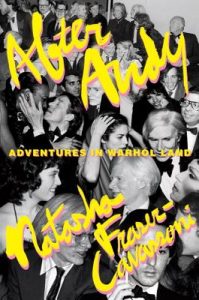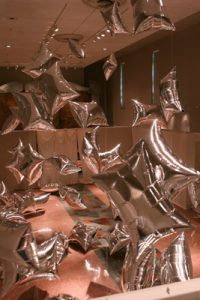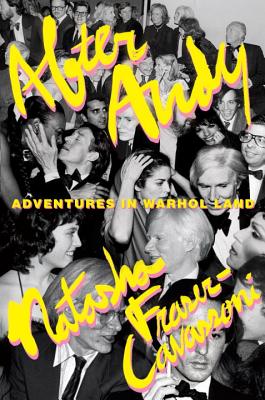 After Andy: Adventures in Warhol Land
After Andy: Adventures in Warhol Land
by Natasha Fraser-Cavassoni
Blue Rider Press. 336 pages, $28.
 3D Warhol: Andy Warhol and Sculpture
3D Warhol: Andy Warhol and Sculpture
by Thomas Morgan Evans
B. Tauris. 264 pages, $24.95
IT HAS BEEN three decades since Andy Warhol died at New York Hospital (on February 22, 1987) of complications from gall bladder surgery. In 2017, over a dozen books about Warhol or his art, ranging from the frivolous to the academic, were published. After Andy and 3D Warhol can be found at either end of that spectrum, the former a fun read by a one-time Warhol groupie, the latter a rather scholarly book by a noteworthy art critic.
After Andy is a memoir by editor-journalist Natasha Fraser-Cavassoni, daughter of British writer Antonia Frasier and step-daughter of the late playwright Harold Pinter. An avid party-goer and flagrant name-dropper, she first met Warhol as a young teen, and a few years later became an “English muffin,” one of a cadre of high-toned young British women who worked in various capacities for the Warhol industry.
Interspersed among Fraser-Cavassoni’s recollections of her (very heterosexual) life—she was, for instance, one of Mick Jagger’s girlfriends—are chapters about Warhol’s art, which are based on the author’s earlier journalism. She also recounts the back story around the truth—or falsehoods—of some of the anecdotes recorded in The Andy Warhol Diaries (posthumously published in 1989) and the sale of his possessions at Sotheby’s to finance the formation of the Andy Warhol Foundation for the Visual Arts.
In describing the importance of his European trips to Warhol’s art, Fraser-Cavassoni goes into detail about The Last Supper (1986), which had been commissioned by influential art dealer Alexander Iolas and opened in Milan six weeks before Warhol’s death. At that time, it was “the largest religious-themed work created by an American artist.” Warhol had apparently purchased a plaster sculpture that he used as source material, but Fraser-Cavassoni also mentions “images found in a Korean religious store and a Jesus night-light newspaper advertisement.” It’s noteworthy that Iolas died at age eighty, just a few months after Warhol, and in the same hospital. But back in 1952, Iolas was running New York’s Hugo Gallery where Warhol had his first solo exhibition, Fifteen Drawings Based on the Writings of Truman Capote.
Thomas Morgan Evans, the author of the densely written 3D Warhol, covers territory not found in many other compendia of Warhol’s works. Evans classifies as “3D” such diverse works as 1964’s Brillo Boxes (which, he said, paved the way for Minimal sculpture and “the erasure of evidence of fabrication”); the 612 Time Capsules (1974-1987, called an “archive of clutter”); soft sculptures (such as the helium-filled Silver Clouds, 1966), and—because it was based, in part, on a 3D object—the silkscreen The Last Supper.

The author posits that Marcel Duchamp’s 1953 show at the Sidney Janis Gallery had been the inspiration for Warhol’s 1954 show at The Loft Gallery. Duchamp had tightly crumpled a poster and displayed it; Warhol pinned elaborately folded paper on The Loft’s walls. As the paper fell from the walls, it became crumpled, and was re-pinned. It had apparently been Warhol’s hope that Silver Clouds would float out the windows of the Castelli Gallery, putting them on par, conceptually, with that “throwaway” crumpled paper exhibit. Evans brings to light some fascinating works, such as The Rain Machine (ca. 1970), described as “a large shower of water in front of a wall of 3D lenticular prints of daisies.” 3D Warhol contains some unexpectedly lovely color plates and black-and-white images. If you have the patience to wade through some academic writing, you’ll find that Evans offers tantalizing insights into Warhol’s lesser-known works of art.
_____________________
Warhol Mania Hits Cambridge, Mass.
In the fall of 2017, the American Repertory Theater (ART) in Cambridge, Massachusetts, premiered a one-act drama, Warhol/Capote, based on many hours of their taped conversations. To celebrate this event, the Harvard Art Museum displayed six of ten screen prints from a Marilyn (1967) portfolio. They are distinguished by their mint condition: they had never been removed from their original packaging, and the colors are vibrant. A beautiful silver-on-gray Marilyn made her look like Marlene Dietrich, while faint vertical lines appeared in the background of a hot pink Marilyn, possibly from the cardboard packing case.
Within a few miles of the ART, two other college-affiliated Warhol exhibits were on view: at Simmons College and at Mass. College of Art and Design. The latter displayed a collection of Polaroids, mostly of socialites and sports figures, many of which were used as source material for future portraits. An attractive and useful gallery catalog, Andy Warhol: What’s the Difference?, edited by Heather Hole, was published for the Simmons exhibit. All works on exhibit are stamped: “Extra, out of the edition” and are leftovers from official prints and portfolios. Some leftovers! There’s the Jackie Triptych (1964), a series of moments before and after JFK’s assassination; Shoes (1980), sprinkled with diamond dust; Sitting Bull, from the 1986 Cowboys and Indians series; and more.






